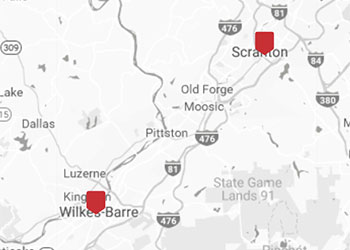Population Dynamics
These statistics are used to determine where potential inequities exist and for whom. Data from several other domains covered in the Indicators Report, including economics, health, housing, and safety, are considered in this section through a social equity lens. Disparities are considered across several dimensions, including race/ethnicity, age, gender, income, and LGBTQIA+ identification.
Black and Hispanic individuals, as well as individuals from multiple racial backgrounds or other races, are likelier than others to have incomes below the poverty line. Workers from those backgrounds are less likely to earn at least $15 per hour, and non-White households had higher rates of cost burden than White households. They are also likelier to rent their homes, whereas homeowners are most likely to be White. Homeownership points to potential for upward economic mobility.
The three counties in the study area share similar income inequality rates: Lackawanna County’s is 0.4627, Luzerne County's is 0.4548, and Wayne County’s is 0.4260. These rates are according to the Gini Index, a summary measure of income inequality. The Gini coefficient ranges from 0, indicating perfect equality (where everyone receives an equal share of income), to 1, perfect inequality (where only one recipient or group of recipients receives all the income).
Women are slightly more likely than men to graduate from high school or college. People without high school diplomas are less likely than those with home internet subscriptions; as such, their access to support and services such as telehealth is limited. Individuals over the age of 65 years are also less likely than others to have home internet subscriptions.
Across Pennsylvania, members of the LGBTQ+ community are more likely than heterosexual and cisgender individuals to be diagnosed with depressive disorders. Men are likelier than women to lack health insurance, as are people without disabilities and people who have not completed high school. Statewide, people who are White are likelier to have health insurance than people who are non-White.
Eliminating disparities is important to the pursuit of social justice. It benefits individuals and families and makes communities and economies more resilient. The more resilient a community is, the better prepared it is to recover from disasters such as the COVID-19 pandemic.
Several cities across the United States have started integrating resilience into their communities’ plans and policies to better respond to uncertainties and crises, including the health, social, and economic impacts of a disaster. Research has demonstrated that hazards disproportionately impact low-income and minority communities, so for a community to be resilient, it is pertinent that the region address inequities in all areas.
According to the 2023 Community Resilience Estimates, majority shares of the populations in Lackawanna, Luzerne, and Wayne Counties have one to two risk factors that affect resilience (41.9 percent, 42.1 percent, and 44.0 percent, respectively).
View Indicators Map

